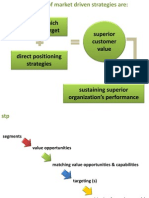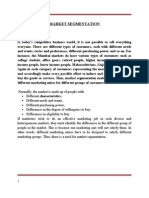Unit 4 - Market Segmentation, Targeting & Positioning (Revised - Sept 2013)
Unit 4 - Market Segmentation, Targeting & Positioning (Revised - Sept 2013)
Uploaded by
Cherrell LynchCopyright:
Available Formats
Unit 4 - Market Segmentation, Targeting & Positioning (Revised - Sept 2013)
Unit 4 - Market Segmentation, Targeting & Positioning (Revised - Sept 2013)
Uploaded by
Cherrell LynchOriginal Description:
Copyright
Available Formats
Share this document
Did you find this document useful?
Is this content inappropriate?
Copyright:
Available Formats
Unit 4 - Market Segmentation, Targeting & Positioning (Revised - Sept 2013)
Unit 4 - Market Segmentation, Targeting & Positioning (Revised - Sept 2013)
Uploaded by
Cherrell LynchCopyright:
Available Formats
UNIT 4
MARKET SEGMENTATION,
TARGETING & POSITIONING
Overview: Segmentation, Targeting
& Positioning
Why do this?
MARKET SEGMENTATION
3
The process of
dividing a large
market into smaller,
distinct groups of
buyers with different
needs, characteristics
or behaviours who
might require
different products or
marketing mixes.
3
Bases for Segmenting Consumer
Markets
4
Occasions, Benefits,
Uses, or Attitudes
Behavioral
Geographic
Region, City or Metro
Size, Density, Climate
Demographic
Age, Gender, Family size
and Life Cycle, Race,
Occupation, or Income ...
Social Class, Lifestyle or
Personality
Psychographic
Figure 8.4 Segmentation for selling salty snacks in the workplace
Source: Adapted from Barron, J. and Hollingshead, J. (2002) Market segmentation work: successful marketing really does begin with effective segmentation, Marketing Management, JanuaryFebruary:
248. Reproduced with permission from J. Barron, J. Hollingshead and the Monitor Group
Segmenting
Business
Markets
The nested
approach to
segmentation
Source: Bonoma, T. V. and Shapiro, B. P.
(1983) Segmenting the Industrial
Market, D.C. Heath and Co., Lexington.
Reproduced with permission from
Rowman and Littlefield Publishing
Group
Effective Segmentation Criteria
Size, purchasing power, profiles
of segments can be measured.
Segments can be effectively
reached and served.
Segments are large or profitable
enough to serve.
Measurable
Accessible
Substantial/Profitable
Differential
Actionable
Segments must respond
differently to different marketing
mix elements & programs.
Effective programs can be
designed to attract and serve
the segments.
7
STUDENT ACTIVITY:
Which variables or descriptors might be most
appropriate for segmenting the market for the
following products? Justify your answer.
1. Breakfast cereals
2. Personal computers/ laptops
3. Lawnmowers
4. Printers
5. Soft Drinks/ Juices
6. Hotels
8
MARKET TARGETING
9
The process of
evaluating each market
segments
attractiveness, and
selecting one or more
segments to enter, using
criteria such as
profitability,
sustainability, level of
competition, market size
etc.
9
TARGETING
Choosing a Target Market
10
Depends on:
Company resources
Product variability
Product life-cycle stage
Market variability
Competitors marketing
strategies
Segment size and growth
Segment structural
attractiveness (see Porters
5-forces Model)
Organizational objectives
and resources
Five Patterns of Target Market Selection
11
Single-segment
concentration
Product
specialization
M1 M2 M3
P1
P2
P3
Selective
specialization
M1 M2 M3
P1
P2
P3
M1 M2 M3
P1
P2
P3
M1 M2 M3
P1
P2
P3
P1
P2
P3
M1 M2 M3
P = Product, M = Market
e.g. Apples focus
on high-end
smartphones
e.g. GM producing
different brands of
vehicles for different
countries
Market
specialization
e.g. baby products
by Johnson &
Johnson
Full market
coverage
e.g. Unilever offers different
brands in different product
categories
e.g. Gillette focuses
on Personal care
items
APPROACHES TO TARGETING:
UNDIFFERENTIATED MARKETING
12
Sometimes referred to as mass marketing the firm may
decide to aim its resources at the entire market with one
particular offer, ignoring all segment differences. One
product aimed at the mass market in the hope that a
sufficient amount of buyers would be attracted.
12
APPROACHES TO TARGETING:
DIFFERENTIATED MARKETING
13
Where the firm decides to target several segments and
develops distinct products/services with separate
marketing mix strategies aimed at the varying groups.
13
APPROACHES TO TARGETING:
CONCENTRATED MARKETING
14
Where the organization concentrates its marketing
effort on one particular segment. The firm will
develop a product that caters for the needs of that
particular group to increase its market share in that
segment.
14
APPROACHES TO TARGETING
MICROMARKETING
15
Local Marketing
Tailoring brands and
promotion to the needs
and wants of local
customer groups:
Cities
Neighborhoods
Stores
Individual Marketing
Tailoring products and
marketing programs to
the needs and
preferences of individual
customers
Also known as:
One-to-one marketing
Mass customization
Markets-of-one marketing
The practice of tailoring products and marketing programs
to suit the tastes of specific individuals and locations
STUDENT ACTIVITY
1. Identify organizations which you believe
adopted the different approaches to
Targeting, and explain why they choose
that approach
2. Identify two (2) companies which
manufacture several products/ brands
that compete with each other. Explain
why the company would choose to do so.
16
MARKET POSITIONING
17
Arranging for a
product/service
to occupy a
clear, distinctive
and desirable
place in the
customers
mind, relative to
other products.
17
POSITIONING CONCEPTS
18
Functional positions
Solve problems
Provide benefits to customers
Get favorable perception by investors (stock profile) and
lenders
Symbolic positions
Self-image enhancement
Ego identification
Belongingness and social meaningfulness
Affective fulfillment
Experiential positions
Provide sensory stimulation
Provide cognitive stimulation
DIFFERENTIATION AND POSITIONING
Positioning
maps use key
variables, as
distinguished
by the target
market, to
show consumer
perceptions of
brands versus
competing
products.
Positioning Strategies
Cult positioning - Harry Potter books.
Origin - Perrier bottled at source.
Positioned with synergistic products and brands -
Bentley and Breitling (high-end Swiss watches).
Positioned against competitors Pepsi vs. Coke
Positioned away from competitors - 7-Up the number 1
Un-cola.
Product class membership - I cant believe its not
butter, the vegetable fat spread, is clearly positioned
against butter.
20
Differentiation and Positioning
Choosing the Right Competitive Advantage
Difference to promote should be:
Important Distinctive Superior
Communicable Preemptive
Affordable
Profitable
STUDENT ACTIVITY
Using and industry of your choice, create a
positioning/ perceptual map identifying where
each company or product would be located.
1. Explain why you choose those specific criteria for
positioning the products (i.e. Axis titles)
2. Select a company/ product and identify which of the
positioning strategies you would recommend. State
why.
22
Differentiation and Positioning
Developing a Positioning Statement
A positioning statement is a succinct description of the core
target audience to whom a brand is directed, and a compelling
picture of how the marketer wants them to view the brand.
There are four elements or components of a positioning
statement:
Target Audience - the attitudinal and demographic description of the core prospect
to whom the brand is intended to appeal; the group of customers that most closely
represents the brands most fervent users.
Frame of Reference- the category in which the brand competes; the context that
gives the brand relevance to the customer.
Benefit/ Point of Difference- the most compelling and motivating benefit that the
brand can own in the hearts and minds of its target audience relative to the
competition.
Reason to believe- the most convincing proof that the brand delivers what it
promises
The Positioning Statement
24
Template for a Positioning Statement:
For (target audience), (brand name) is the (frame of
reference) that delivers (benefit/point of difference)
because only (brand name) is reason to believe).
Criteria for Evaluating a Positioning Statement:
1. Is it memorable, motivating and focused to the core prospect?
2. Does it provide a clear, distinctive and meaningful picture of the brand
that differentiates it from the competition?
3. Can the brand own it?
4. Is it credible and believable?
5. Does it enable growth?
6. Does it serve as a filter for brand decision-making?
Examples of Positioning Statements
25
For those suffering from a cold,
Comtrex offers four different relief
formulas that treat and work
against your specific cold
ailments
For consumers ages 16-35, Crest
Whitestrips whiten teeth five times
better than the leading paint-on
whitening gel. Thats because
Crests gel-coated strips hold the
peroxide on teeth longer, to whiten
stains below the tooth surface.
Common and serious positioning
errors
26
Under-positioning
A positioning error referring to failure to position a
company, its product or brand.
Over-positioning
A positioning error referring to too narrow a picture of
the company, its products or a brand being
communicated to target customers.
Confused positioning
Leaves consumers with a confused image of the
company, its product or brand.
Implausible positioning
Making claims that stretch the perception of the
buyers too far to be believed.
You might also like
- Consumer Behaviour, Assignment 1Document3 pagesConsumer Behaviour, Assignment 1Arpana GuptaNo ratings yet
- Consumer BehaviorDocument54 pagesConsumer BehaviorGuruKPO100% (5)
- 7 oDocument37 pages7 osramuspjimr100% (2)
- S&DM - Prof. Pingali VenugopalDocument1 pageS&DM - Prof. Pingali VenugopalSwapnil KulkarniNo ratings yet
- Chapter 1 Market ResearchDocument11 pagesChapter 1 Market ResearchRuby De GranoNo ratings yet
- Pricing Concepts in MarketingDocument45 pagesPricing Concepts in MarketingParamjit Sharma100% (5)
- Segmentation, Targeting and PositioningDocument8 pagesSegmentation, Targeting and PositioningNilesh SinghNo ratings yet
- Sales ForecastingDocument15 pagesSales ForecastingHari KrishnanNo ratings yet
- Rediscovering Market SegmentationDocument16 pagesRediscovering Market Segmentationraaiedjay100% (1)
- Chapter 13 - Setting Product StrategyDocument33 pagesChapter 13 - Setting Product StrategyAnuj ChandaNo ratings yet
- CB AssignmentDocument17 pagesCB AssignmentKuldeep TomarNo ratings yet
- VI SEM B.B.M Subject BRAND MANAGEMENTDocument42 pagesVI SEM B.B.M Subject BRAND MANAGEMENTAbhishek DANo ratings yet
- Dmba102 Business CommunicationDocument8 pagesDmba102 Business CommunicationShashi SainiNo ratings yet
- Segmenting, Targeting & PositioningDocument41 pagesSegmenting, Targeting & PositioningDr. Geetanjali Bendale100% (1)
- Chapter 1 - Tapan Panda Sales and Distribution ManagementDocument42 pagesChapter 1 - Tapan Panda Sales and Distribution ManagementDipyaman Choudhury100% (1)
- Marketing Research: WWW - Sba.gov/smallbusinessplanner/manage/market andprice/SERV-MARKETRESEARCH - HTMLDocument47 pagesMarketing Research: WWW - Sba.gov/smallbusinessplanner/manage/market andprice/SERV-MARKETRESEARCH - HTMLMateytsNo ratings yet
- 4 7Ps Marketing Mix PowerPointDocument7 pages4 7Ps Marketing Mix PowerPointDavid Gutierrez100% (1)
- Marketing Ethics and CSRDocument3 pagesMarketing Ethics and CSRStanley CheruiyotNo ratings yet
- b2b Industrial Marketing NotesDocument14 pagesb2b Industrial Marketing NotesAnkita SthapakNo ratings yet
- Chapter 6 - Customer-Driven Marketing Strategy-Creating Value For Target CustomersDocument45 pagesChapter 6 - Customer-Driven Marketing Strategy-Creating Value For Target Customersxueting100% (1)
- Titan Advertisement and Sales Promotion StrategyDocument16 pagesTitan Advertisement and Sales Promotion StrategyArpit Jain0% (1)
- Services Marketing 2 - Consumer Behavior in ServicesDocument50 pagesServices Marketing 2 - Consumer Behavior in ServicesAnkapa Naidu DamaNo ratings yet
- Deciding Which Buyers To Target Superior Customer ValueDocument23 pagesDeciding Which Buyers To Target Superior Customer ValueFaisal JanNo ratings yet
- The Impact of Marketing Mix On Consumer Buying BehaviourDocument11 pagesThe Impact of Marketing Mix On Consumer Buying BehaviourJEWEL TUAZONNo ratings yet
- Fundamentals of MarketingDocument18 pagesFundamentals of MarketingSoma GiriNo ratings yet
- MARKET SEGMENTATION, TARGETING & POSITIONING - by Arihant Aski GoswamiDocument26 pagesMARKET SEGMENTATION, TARGETING & POSITIONING - by Arihant Aski GoswamiArihant Aski Goswami93% (15)
- Strategic Marketing, 3 Edition: Chapter 5: Segmentation, Targeting, and Positioning StrategiesDocument31 pagesStrategic Marketing, 3 Edition: Chapter 5: Segmentation, Targeting, and Positioning StrategiesWAI SUM SONo ratings yet
- Demand Forecasting PDFDocument43 pagesDemand Forecasting PDFmasratjahan32_453199No ratings yet
- Consumer Behavior NotesDocument63 pagesConsumer Behavior NotesNaeem KhanNo ratings yet
- Practical Guide Introduction To Marketing v3Document10 pagesPractical Guide Introduction To Marketing v3Raveesh HurhangeeNo ratings yet
- Tentative Questions Students B2B MarketingDocument1 pageTentative Questions Students B2B MarketingVamsee Krishna Vyas BNo ratings yet
- Marketing Strategy: Citations VerificationDocument7 pagesMarketing Strategy: Citations VerificationBrijesh YadavNo ratings yet
- Marketing Research IntroductionDocument40 pagesMarketing Research IntroductionBalaji N100% (5)
- Explain Bases of Market SegmentationDocument29 pagesExplain Bases of Market SegmentationPriyanka Patil100% (7)
- 1 Introduction KotlerDocument37 pages1 Introduction KotlerAjiteshwar ShuklaNo ratings yet
- Different Consumer Behaviour RolesDocument5 pagesDifferent Consumer Behaviour RolesShafak Mahajan100% (2)
- Retail CommunicationsDocument47 pagesRetail CommunicationsArshiya JabeenNo ratings yet
- Marketing Case StudyDocument2 pagesMarketing Case StudyJulius Dennis100% (1)
- Clean Edge Razor-Case PPT-SHAREDDocument10 pagesClean Edge Razor-Case PPT-SHAREDPoorvi SinghalNo ratings yet
- Retail Marketing Mix and PlanningDocument28 pagesRetail Marketing Mix and PlanningNavin Mehta100% (1)
- Market SegmentationDocument24 pagesMarket SegmentationDrRumana ShaikhNo ratings yet
- 02 Product DecisionDocument38 pages02 Product DecisionJemima Christelle EkraNo ratings yet
- Consumer BehaviourDocument45 pagesConsumer Behaviourr100% (1)
- Entrepreneurship Case Study 2Document3 pagesEntrepreneurship Case Study 2glNo ratings yet
- Schiffman cb11 Ippt11Document29 pagesSchiffman cb11 Ippt11frq qqrNo ratings yet
- Chapter 4 - Creating Customer Value, Satisfaction, and LoyaltyDocument30 pagesChapter 4 - Creating Customer Value, Satisfaction, and LoyaltyArman100% (1)
- Workbook/Presentation On Segmentation, Targeting and Positioning of MarketDocument59 pagesWorkbook/Presentation On Segmentation, Targeting and Positioning of MarketPandurang Shinde100% (1)
- Strategic Marketing Unit 1Document13 pagesStrategic Marketing Unit 1Rishabh GangwarNo ratings yet
- Relationship Marketing in Retailing & International RetailingDocument72 pagesRelationship Marketing in Retailing & International Retailingkiran 17mba11No ratings yet
- CB ModelsDocument37 pagesCB ModelspraveenaNo ratings yet
- Course Outline Consumer Behavior UpdatedDocument23 pagesCourse Outline Consumer Behavior Updatedkhanbaba1998No ratings yet
- Mba 806 Marketing Management2021Document43 pagesMba 806 Marketing Management2021SIMON SONGA PETERNo ratings yet
- Sales and Distribution ManagementDocument21 pagesSales and Distribution Managementshubhro gomesNo ratings yet
- Distribution - MarketingDocument17 pagesDistribution - MarketingSneha SinghNo ratings yet
- Module 3: Product and Service Strategies (WEEK 6)Document20 pagesModule 3: Product and Service Strategies (WEEK 6)ESPINOLA MARGIENo ratings yet
- Marketing: 5, 6, 7, 8, 9 and 10Document16 pagesMarketing: 5, 6, 7, 8, 9 and 10Ana García BarbelNo ratings yet
- Brand PositioningDocument59 pagesBrand PositioningVishal Singh JaswalNo ratings yet
- EBS Prospectus2016 17Document40 pagesEBS Prospectus2016 17Cherrell LynchNo ratings yet
- Criteria Weight (%) Performance Comment: Description of The Key Issues / Problem / OrganisationDocument1 pageCriteria Weight (%) Performance Comment: Description of The Key Issues / Problem / OrganisationCherrell LynchNo ratings yet
- UOS BABM Application ChecklistDocument1 pageUOS BABM Application ChecklistCherrell LynchNo ratings yet
- Dmeup 09Document4 pagesDmeup 09Cherrell LynchNo ratings yet
- Request For Clearance Form: Surname First Middle TitleDocument2 pagesRequest For Clearance Form: Surname First Middle TitleCherrell LynchNo ratings yet
- Metals WorksheetDocument1 pageMetals WorksheetCherrell LynchNo ratings yet
- CXC Past Paper 1 June 2010Document11 pagesCXC Past Paper 1 June 2010Cherrell LynchNo ratings yet
- Study Time Table TemplateDocument3 pagesStudy Time Table TemplateCherrell LynchNo ratings yet
- ABC in ServiceDocument6 pagesABC in ServiceCherrell LynchNo ratings yet
- A Literature Review On The Impact of Enterprise Systems On Management AccountingDocument27 pagesA Literature Review On The Impact of Enterprise Systems On Management AccountingCherrell LynchNo ratings yet
- PESTLE Factors: PoliticalDocument5 pagesPESTLE Factors: PoliticalCherrell LynchNo ratings yet
- CAL ConclusionDocument3 pagesCAL ConclusionCherrell LynchNo ratings yet
- SIM336 Lecture Sequence Wayne Homer - Feb To May 2014 SMDocument1 pageSIM336 Lecture Sequence Wayne Homer - Feb To May 2014 SMCherrell LynchNo ratings yet
- Our Mission, Vision & ValuesDocument3 pagesOur Mission, Vision & ValuesCherrell LynchNo ratings yet
- Assignment #4A-Thursday 24 October 2013: Part 1 Questions - April 2011Document1 pageAssignment #4A-Thursday 24 October 2013: Part 1 Questions - April 2011Cherrell LynchNo ratings yet
- Java Lab InheritanceDocument6 pagesJava Lab InheritanceSantanuSarkar100% (1)
- M Type TubesDocument26 pagesM Type Tubes020 D.M HASIBUR RAHMAN 18No ratings yet
- Fugazzotto 2002 IJOMI - Osteotome Technique and 2x-2Document8 pagesFugazzotto 2002 IJOMI - Osteotome Technique and 2x-2Zhiyi LinNo ratings yet
- Juice Factory Training PlanDocument38 pagesJuice Factory Training Plansameh mokhtarNo ratings yet
- Ships Particulars Normal Type 116 - Vers. 2021 04Document2 pagesShips Particulars Normal Type 116 - Vers. 2021 04Álvaro Rodríguez BNo ratings yet
- New Light On The Legendary King Nechepsos - 2011Document12 pagesNew Light On The Legendary King Nechepsos - 2011fvfilipovNo ratings yet
- The Halliburton Employment Application FormDocument4 pagesThe Halliburton Employment Application FormNur SyahimaNo ratings yet
- Location Awareness Programming GuideDocument62 pagesLocation Awareness Programming GuideBoilerplate4uNo ratings yet
- BOSH Week 2Document17 pagesBOSH Week 2Marion DominoNo ratings yet
- Anthony Lellouche: Work Experience SkillsDocument1 pageAnthony Lellouche: Work Experience Skillsadmin StilyoAppsNo ratings yet
- Price Ice BoxDocument2 pagesPrice Ice BoxHaffiz AtingNo ratings yet
- Landforms of The EarthDocument4 pagesLandforms of The EarthRatul RanjanNo ratings yet
- CH1 ROBLES & EMPLEO Intermediate Accounting Vol. 1Document39 pagesCH1 ROBLES & EMPLEO Intermediate Accounting Vol. 1Aiki VillorenteNo ratings yet
- Practical Research 1 (Chapters 1-3)Document63 pagesPractical Research 1 (Chapters 1-3)Sofia EgbalicNo ratings yet
- KooyooDocument30 pagesKooyoochandru2619No ratings yet
- Number SystemDocument29 pagesNumber Systemsamana samiNo ratings yet
- Open Syllables Mini-Lesson.: TeacherDocument5 pagesOpen Syllables Mini-Lesson.: TeacherAnooshay ShahzaibNo ratings yet
- Frantinco E Catalog Vinyl FlooringDocument30 pagesFrantinco E Catalog Vinyl Flooringdan diNo ratings yet
- సచివాలయంలో ఆధార్ సేవలుDocument4 pagesసచివాలయంలో ఆధార్ సేవలుVamsiNo ratings yet
- Live Notes Ai SL Math Bridge Program 2022Document34 pagesLive Notes Ai SL Math Bridge Program 2022sriramaniyerNo ratings yet
- Greater Yangon Project Plan (Yutra)Document251 pagesGreater Yangon Project Plan (Yutra)Pperfect Ccatch100% (6)
- Chapter 6 (On Geometric Designs)Document67 pagesChapter 6 (On Geometric Designs)Joshua SumillaNo ratings yet
- Supply Chain Management Question Bank: P A RT - ADocument16 pagesSupply Chain Management Question Bank: P A RT - APraveen Perumal PNo ratings yet
- Rinac Make 59 X 26 X 10 & 37 X 15 X 10 FeetDocument10 pagesRinac Make 59 X 26 X 10 & 37 X 15 X 10 FeetMan MohanNo ratings yet
- Donor'S Tax: Statement 2Document4 pagesDonor'S Tax: Statement 2Shalom May CatedrillaNo ratings yet
- T24-IT-Comments-Signed Off BRD For IBAN ProjectDocument32 pagesT24-IT-Comments-Signed Off BRD For IBAN Projectnobodyknows706No ratings yet
- Impossibility of Distributed Consensus With One Faulty ProcessDocument7 pagesImpossibility of Distributed Consensus With One Faulty ProcessPavanNo ratings yet
- Mark Scheme (Results) : Summer 2018Document22 pagesMark Scheme (Results) : Summer 2018RafaNo ratings yet
- Archana Bhise Resume 2024Document3 pagesArchana Bhise Resume 2024ulhas.maargeenNo ratings yet







































































































